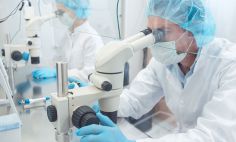Health Topics

What is it like to research a rare disease?
Urea cycle disorder principal investigator shares her experience
Andrea L. Gropman, M.D., studies rare diseases with support from NIH and the Rare Diseases Clinical Research Network. She talked about what it's like to research a rare disease as a principal investigator on the Urea Cycle Rare Diseases Consortium. She has been studying the disorder for 14 years.
What is a urea cycle disorder?
A urea cycle disorder results from an inability to safely dispose of nitrogen in the body. When our bodies break down protein, we create nitrogen that is used for many chemical reactions in the body for growth, and excess nitrogen is made into a nontoxic chemical called urea that we get rid of through our urine.
But when that process goes wrong, in people with urea cycle disorders, the excess nitrogen is not flushed out through our urine. Instead, the nitrogen builds up as ammonia in our bodies and causes damage, particularly in the brain.
How do people get the disorder?
Urea cycle disorders are genetic conditions. They can arise from inheriting a mutated gene from the parents or it may start as a new condition in the patient.
How many patients have a urea cycle disorder?
We think that it's about 1 in 30,000. We don't know the exact number of patients out there because many individuals remain undiagnosed or have very mild symptoms, especially adults.
What kind of research does the Urea Cycle Rare Diseases Consortium work on?
The goals of our consortium are to better understand what causes urea cycle disorders, to study the natural history of these disorders, and develop new treatments. Already, our consortium has improved the care of adults and children with urea cycle disorders. We are now looking at related issues, like liver conditions that may develop later in life.
We're currently working on expanding newborn screening to all urea cycle types (there is screening available for some of the types of urea cycle disorders now) so they can be identified before brain injury has set in.
Can you tell us some specifics?
My project in particular uses magnetic resonance imaging (MRI) to look at the long-term effects of hyperammonemia on the brain. People's attention and their working memory are impacted by urea cycle disorder and there are changes in brain structure and networks that we can study using MRI.
What's something we may not know about urea cycle disorder research?
Many of our researchers have been working for decades on urea cycle disorders. And we also have junior investigators who are training under more senior researchers to carry on this research. That's one of the basic requirements of the network, that there be a substantial commitment to educating the next generation of physicians and researchers in rare disease.
What advice do you have for patients of rare diseases?
For a patient or the family of a patient, it's often helpful to align yourself with advocacy groups for that disorder. Those groups are partners with us in our research design and study and are very supportive of families.
Patients actually provide a lot of valuable suggestions to us as researchers because they are living with the disease. We always want to hear from patients.
And for patients who may think they have symptoms of a rare disease, they should discuss that with their physician and possibly bring information with them, such as family history, unusual dietary preferences, or unusual blood work results.







